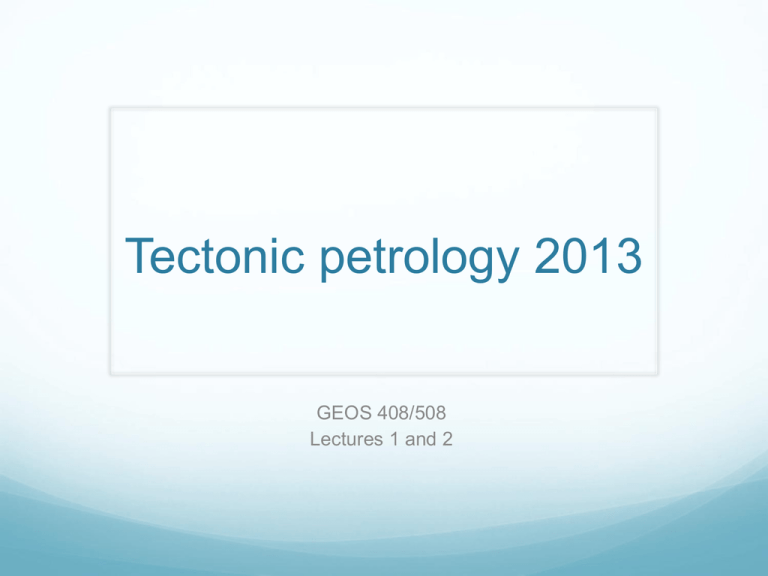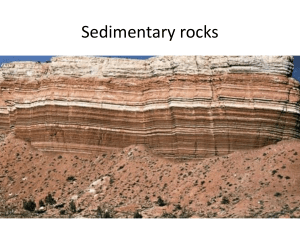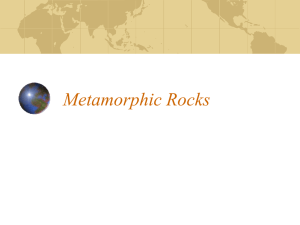508_2k13_lec1_2
advertisement

Tectonic petrology 2013 GEOS 408/508 Lectures 1 and 2 Target audience Tectonicists and geologists working with hard rocks, but not as primary observational tools; Those who want to fill gaps in igneous and metamorphic petrology without going back to basic petrology/petrography Organization Petrography and geochem tools (lec 1-10) Physical properties (lec 11-13) Melting in the Earth (lecs 14-18) Rocks and tectonic settings – remainder of class Comprehensive cover/case study Assumptions Pathway to interpretations • Igneous petrology semantics • Modern plate tectonics settings and petrology • Rules for tectonic interpretation • Limitations • Tools, resources Petrography Descriptive discipline aimed at describing rocks; Can be based on mineralogical and textural observations - intrusive and hypabyssal rocks; Based primarily on chemistry - volcanic rocks Petrology Discipline that interprets suites of rocks in a spatiotemporal framework in order to either: Better understand the physical mechanisms for magmatic/metamorphic processes or Provide a framework for tectonic interpretations. An example Rocks representing the northern Sierra Nevada batholith (lat. of Lake Tahoe), previously little studied in comparison to the more southern exposures. Cecil et al., 2012 Major questions What are the rocks? When did they form? What tectonic framework do they represent (subduction, extension, etc)? Can they provide info regarding the local/regional tectonic evolution? Petrographic composition - a suite ranging from diorites to granodiorites Geochronology-magmatic Stratigraphic - intrusive relationships, volcanic stratigraphy; Good start, but usually large errors; Whole-rock Sr, Nd or common Pb isochrons; numerous data obtained in the early days of quant. geochron, relies heavily on closed-system assumptions; Zircon U-Pb geochron, best tool for intermediate to acidic rocks of a wide range of ages;zircons may be too small in some volcanic rocks; Other U-rich mineral (apatite, sphene) U-Pb,good precision but could represent cooling; Ar-Ar (or K-Ar) chronometry on mafic and a variety of K-rich rocks; great for volcanic rocks, high precision for a wide range of ages; Other isochron methods (K-Ca, Re-Os), rarely used, difficult methods. Geochronology-metamorphic Sm-Nd and Lu-Hf isochrons using garnet - the most robust methods for determining the age of metamorphism, when garnet present; U-Pb monazite chronology - monazite, when present in metamorphic rocks, is formed during prograde metamorphism U-Pb zircon chronology, with the caveat that most zircons, except in high grade metamorphism, are (or can be) pre-metamorphic; Rb-Sr isochron chronology on lower grade rocks, mid-temperature ductile shearing events and/or lower grade imprints on high grade rocks - works well when biotite or muscovite are present. Petrography Igneous petrography Volcanics - chemical Intrusive - mineralogical/modal Major Elements Modern Spectroscopic Techniques Emitted radiation Energy Source Emission Detector Absorbed radiation Sample Output with emission peak Absorption Detector Output with absorption trough The geometry of typical spectroscopic instruments. From Winter (2001) An Introduction to Igneous and Metamorphic Petrology. Prentice Hall. Volcanic petrography Rocks are fine grained, could be glassy, aphanitic, with some phenocrysts. Makes sense to classify them using either an initial field scheme (color index, indicative phenocrysts) and later based on major element chemistry. A typical rock analysis Wt. % Oxides to Atom % Conversion Oxide Wt. % Mol Wt. Atom prop Atom % SiO2 49.20 60.09 0.82 12.25 TiO2 1.84 95.90 0.02 0.29 Al2O3 15.74 101.96 0.31 4.62 Fe2O3 FeO MnO MgO CaO Na2O 3.79 7.13 0.20 6.73 9.47 2.91 159.70 71.85 70.94 40.31 56.08 61.98 0.05 0.10 0.00 0.17 0.17 0.09 0.71 1.48 0.04 2.50 2.53 1.40 K2O 1.10 94.20 0.02 0.35 H2O+ (O) Total 0.95 18.02 0.11 4.83 6.69 1.58 72.26 100.00 99.06 Must multiply by # of cations in oxide Chemical analyses of some representative igneous rocks Peridotite Basalt Andesite SiO2 42.26 49.20 57.94 TiO2 0.63 1.84 0.87 Al2O3 4.23 15.74 17.02 Fe2O3 3.61 3.79 3.27 FeO 6.58 7.13 4.04 MnO 0.41 0.20 0.14 MgO 31.24 6.73 3.33 CaO 5.05 9.47 6.79 Na2O 0.49 2.91 3.48 K2O 0.34 1.10 1.62 H2O+ 3.91 0.95 0.83 Total 98.75 99.06 99.3 Rhyolite Phonolite 72.82 56.19 0.28 0.62 13.27 19.04 1.48 2.79 1.11 2.03 0.06 0.17 0.39 1.07 1.14 2.72 3.55 7.79 4.30 5.24 1.10 1.57 99.50 99.23 LOI Difference to 100% represents the Loss Of Ignition and may or may not represent primary volatile (water, CO2, etc) concentration in the rock. Analysis by XRF; If glassy, analysis can be done via electron microprobe. Rock classifications TAS (total alkalies versus silica); AFM (alkali-iron -magnesium) Cecil, 2012 Alkali vs. Silica diagram for Hawaiian volcanics: Seems to be two distinct groupings: alkaline and subalkaline Total alkalis vs. silica diagram for the alkaline and sub-alkaline rocks of Hawaii. After MacDonald (1968). GSA Memoir 116 Bivariate (x-y) diagrams Harker diagram for Crater Lake Harker variation diagram for 310 analyzed volcanic rocks from Crater Lake (Mt. Mazama), Oregon Cascades. Fractionation Mixing AFM diagram: can further subdivide the subalkaline magma series into a tholeiitic and a calc-alkaline series AFM diagram showing the distinction between selected tholeiitic rocks from Iceland, the Mid-Atlantic Ridge, the Columbia River Basalts, and Hawaii (solid circles) plus the calc-alkaline rocks of the Cascade volcanics (open circles). From Irving and Baragar (1971). After Irvine and Baragar (1971). Can. J. Earth Sci., 8, 523-548. Ternary Variation Diagrams Example: AFM diagram (alkalis-FeO*-MgO) AFM diagram for Crater Lake volcanics, Oregon Cascades. Ternary diagrams Need a handy way to plot; IgPet plots petrographic boundaries over data. Alkalinity indexes Alumina saturation classes based on the molar proportions of Al2O3/(CaO+Na2O+K2O) (“A/CNK”) after Shand (1927). Common non-quartzo-feldspathic minerals for each type are included. After Clarke (1992). Granitoid Rocks. Chapman Hall. a. Plot of CaO (green) and (Na2O + K2O) (red) vs. SiO2 for the Crater Lake data. Peacock (1931) used the value of SiO2 at which the two curves crossed as his “alkali-lime index” (dashed line). b. Alumina saturation indices (Shand, 1927) with analyses of the peraluminous granitic rocks from the Achala Batholith, Argentina (Lira and Kirschbaum, 1990). In S. M. Kay and C. W. Rapela (eds.), Plutonism from Antarctica to Alaska. Geol. Soc. Amer. Special Paper, 241. pp. 67-76. Richness in K - defines subclasses for volcanic rocks Volcanic rocks What is QAP? Q= quartz, A= alkalifeldspar, P=plagioclase Can be modal (intrusive, exclusively crystalline rocks), or normative (volcanic rocks) Normative = a formula that assigns minerals that would form if a certain magmatic chemical composition would crystallize. The normative formula used in petrology for over 100 years is the CIPW norm. CIPW Norm • Mode is the volume % of minerals seen • Norm is a calculated “idealized” mineralogy Oxide SiO2 TiO2 Al2O3 Fe2O3* MgO CaO Na2O K2O Total Wt% 46.5 1.4 14.2 11.5 10.8 11.5 2.1 0 98.1 Cation Norm ab 18.3 an 30.1 di 23.2 hy 4.7 ol 19.3 mt 1.7 il 2.7 100 Norm rules All rocks with <90% mafic minerals are classified according to their relative percentage of 3 felsic minerals They are Plag and Alkali feldspar plus either a feldspathoid (if they are silica undersaturated) or Quartz if they are silica oversaturated; Consequently, the rock nomenclature will be defined on a ternary diagram. Rocks with > 90% mafics are classified separately. Plutonic rocks After Streckeisen, 1937. HW 1 Use the major elements in Cecil’s N Sierra database to determine the CIPW norms, and plot them on a QAP diagram; Plot an AFM diagram for the same data and determine if they follow a tholeiitic or calc-alkaline path. CIPW Thermal divide separates the silica-saturated (subalkaline) from the silica-undersaturated (alkaline) fields at low pressure Cannot cross this divide by FX, so can’t derive one series from the other (at least via low-P FX) 1713 Liquid Thermal Divide 1070 Ne + L Ab + LAb + L Ne + Ab Ne Tr + L 1060 Ab + Tr Ab Q Peridotites: Olivine +Opx + Cpx Olivine Dunite 90 Peridotites Lherzolite 40 Pyroxenites Olivine Websterite Orthopyroxenite 10 10 Orthopyroxene Websterite Clinopyroxenite Clinopyroxene Gabbros Norms and modes For a volcanic rock, either use the TAS classification or calculate norms; For a plutonic rocks, modes and norms should coincide. Modes can be point counted on representative thin sections whereas norms are determined from the major element chemistry using the CIPW algorithm. HW 2 I provide an excel file (TRENCH) which contains the average sedimentary major element compositions (in oxides) for two modern trenches. Use a CIPW routine to determine the average petrographic composition of the nearby arcs, assuming that the composition is representative for an arc-wide area. Were they island arcs, or mature Cordilleran (andean) arcs? Programs to use for majors GCDkit - only for Windows users; IGPet - distributed in class (tutorial to be provided in class on Tuesday); Petroplotting - an old but nice excel app; NORM - another excel program that performs CIPW calculations;








